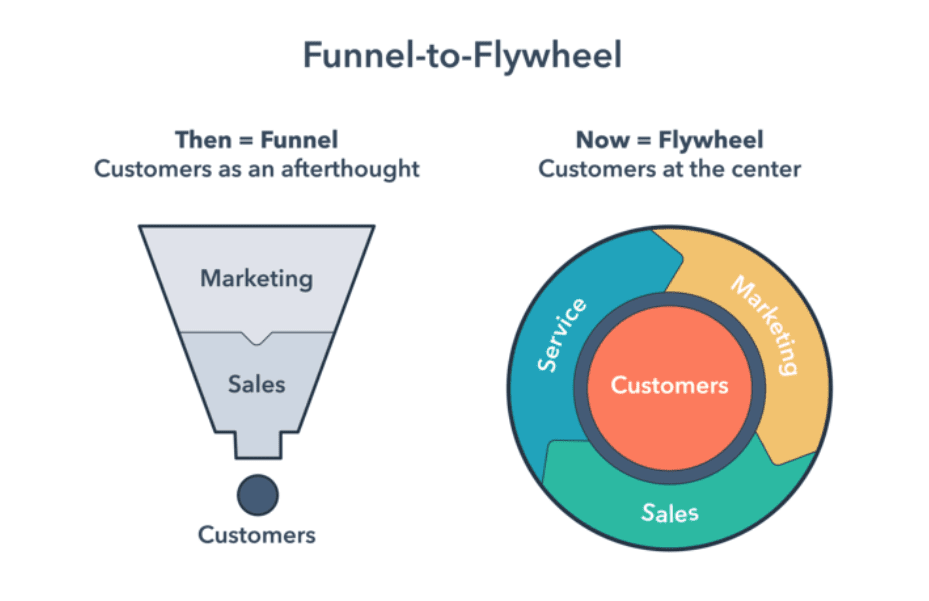How moving from the funnel to a flywheel drives growth and customer delight.
For years, marketing teams have structured their strategies around the funnel — and it worked. But recently, the funnel model has begun to fail marketers and business leaders alike.
Today, customer referrals and word-of-mouth have become the largest influence on the purchase process, which means the funnel has one major flaw: It views customers as an afterthought, not a driving force. Funnels produce customers but don’t consider how those customers can help you grow. What happens to customers in the funnel? They’re the outcome — nothing more, nothing less. All of the energy you spent acquiring that customer is wasted, leaving you at square one.
That’s where the flywheel comes into play.
What Is the Flywheel?
Unlike the funnel, the flywheel is remarkable at storing and releasing energy — and it turns out that’s pretty important when thinking about your school or college's business strategy. Invented by James Watt, the flywheel is simply a wheel that’s incredibly energy-efficient. The amount of energy it stores depends on how fast it spins, the amount of friction it encounters, and its size. Think of it like the wheels on a train or a car.
This energy is especially helpful when thinking about how current students (and their families) can help your organisation grow.
With the flywheel, you use the momentum of your happy customers to drive referrals and recommendations. Basically, your business keeps spinning.
This isn’t a marketing ploy. We’re not debating jargon. And we’re definitely not redefining the same process.
When you think about your business as a flywheel instead of a funnel, you make different decisions and adjust your strategy. To demonstrate, let us first explain how the flywheel works.

How It Works
The amount of energy, or momentum, your flywheel contains depends on three things:
- How fast you spin it
- How much friction there is
- How big it is
The most successful companies will adjust their business strategies to address all three. The speed of your flywheel increases when you add force to areas that have the biggest impact - like improving the service provided by your student-facing teams. By focusing on how you can make your students successful, they’re more likely to relay their success to other potential students.
Remember, every education provider is different, and the way you design your flywheel is dependent on your model. Figure out the teams and areas of your business that have the biggest impact on growth - often those who impact the customer journey or those delivering the education. Personalise your flywheel by leveraging those insights and applying force to those areas.
Since you’re applying force to your flywheel, you also need to make sure nothing is opposing it — that means eliminating friction from your strategy. You can reduce friction by looking at how your teams are structured, why students are dissatisfied, and where prospects are getting stuck in the admissions journey.
Are all your teams aligned or are they operating in silos? Is your pricing straightforward or is it cluttered with confusing fees? Do you allow prospects to connect with you how, when, and where they want or are they forced to follow your strict process?
The more you increase speed and decrease friction, the more you will create promoters of your organisation. And all those promoters make for one big flywheel.
Organisation that choose to use the flywheel model over the typical funnel have a huge advantage because they aren’t the only ones helping their business grow — their customers are helping them grow as well.
That’s a much more efficient way to attract new customers and retain existing ones.
The flywheel also helps eliminate friction and reduce clumsy handoffs between teams. In the funnel model, students (or their parents) are often shuffled from marketing to admissions to admin/services teams and eventually teachers or Heads of Year/Subject. This can lead to a pretty unpleasant student experience.
But with the flywheel model, the onus is on every team in the entire school or college to attract, engage, and delight customers. When all of your teams are aligned around the inbound methodology, you can provide a more holistic, delightful experience to anyone who interacts with your organisation.
Why You Should Care
The flywheel model is a more comprehensive, unified way of representing the forces affecting your organisation’s growth.
The actions taken by each team at your school or college impact each other. Your marketing inputs affect how quickly prospective students move through your admissions process. Your admissions experience affects how likely it is prospects will become happy and successful students. And of course, your support and service activities impact whether your students become promoters — people who recommend you to their friends — or warn their networks to stay away.
Conversations happen in more places, among more people, than ever before. The funnel was a good representation of how buyers used to learn about products — they found (or were sent) marketing materials, they had to speak to salespeople to find out more information, and then they became customers.
But that’s not how people make decisions today. They ask their networks for advice, they search for mentions of your company on social media, and you bet they’re reading third-party review sites.
The traditional funnel doesn’t account for any of these factors. And because they’re linear, funnels don’t reveal the momentum you build through a great product and customer experience, nor the drag you experience when your processes start to slow down growth.
The flywheel is the mental model that brings these forces together. Removing friction from your internal processes means you can spin your flywheel — and grow — faster. And most importantly, when paired with the inbound methodology, the flywheel reveals the importance of the student experience. The “delight” stage powers the “attract” stage of the inbound methodology, because of course how you treat your students and their families affects what prospects hear about you.
Simply put, the flywheel is a more comprehensive look at where your organisation is growing fastest, and it reveals your biggest areas of opportunity.
Feeling inspired and considering your next steps? Arrange a free consultation with an education marketing and inbound expert.
.png?width=150&height=101&name=HUBGEM%20Logo%20-%20smaller%20logo%20(1000%20x%20673).png)


.png)

.png)


